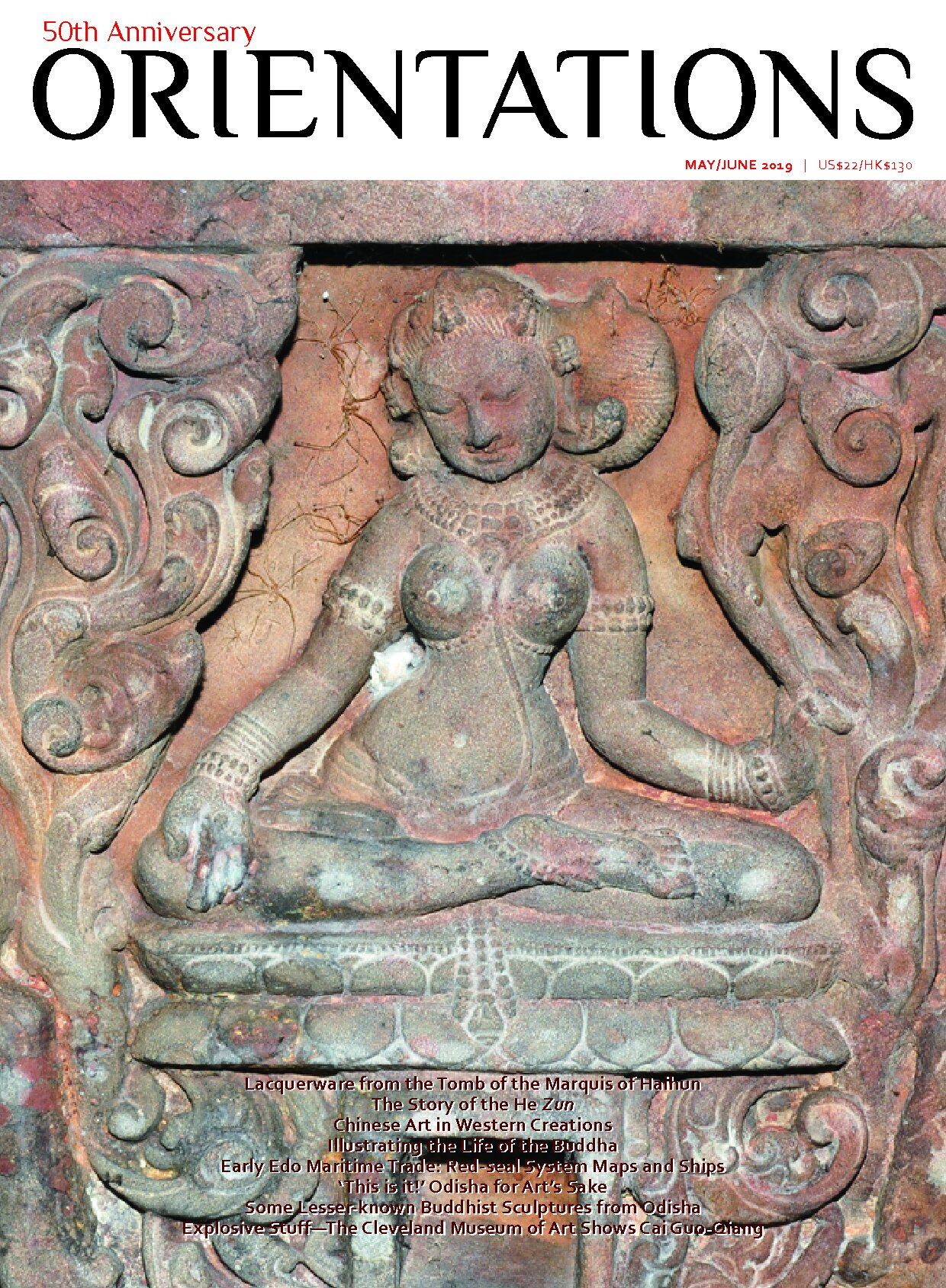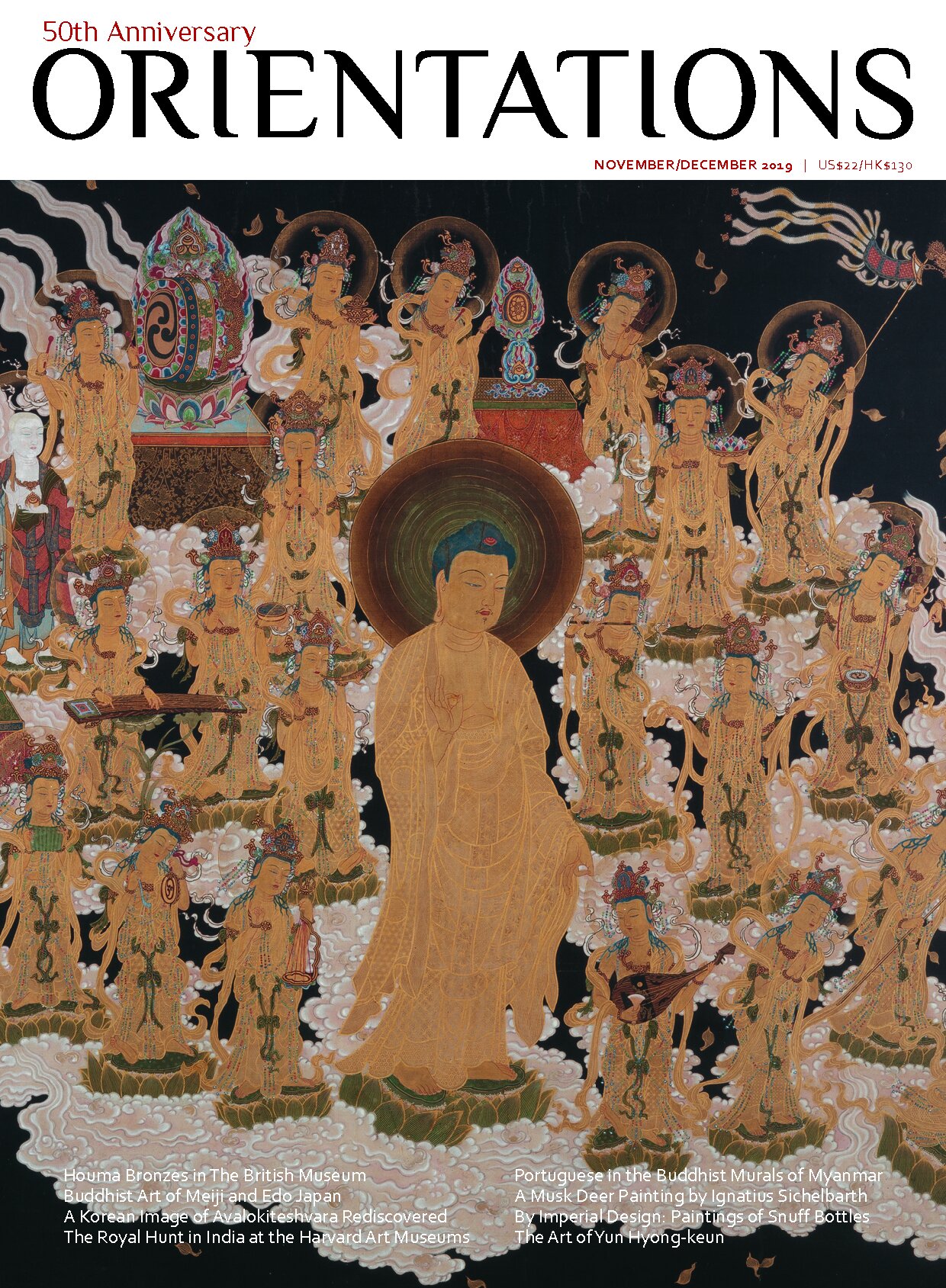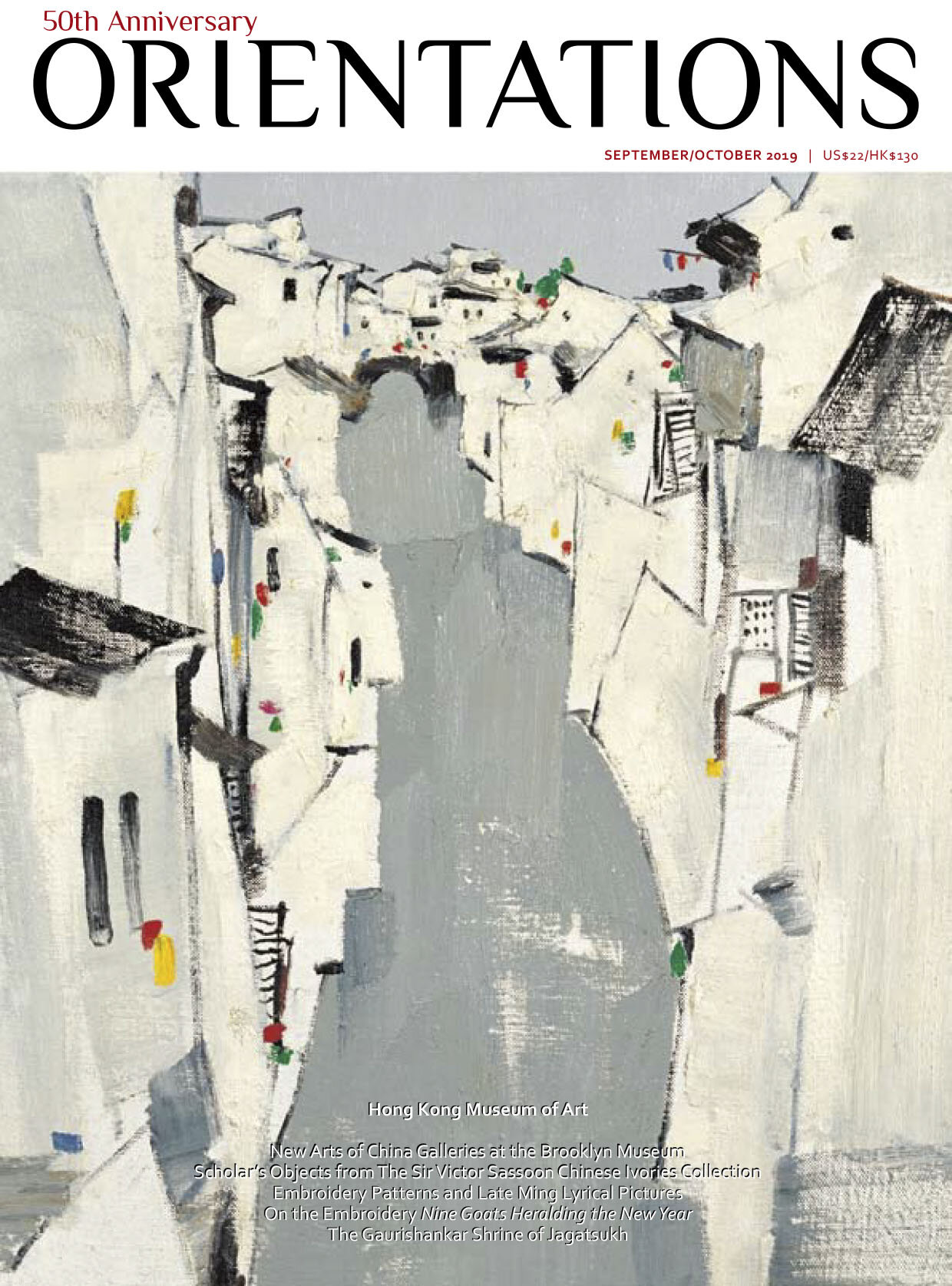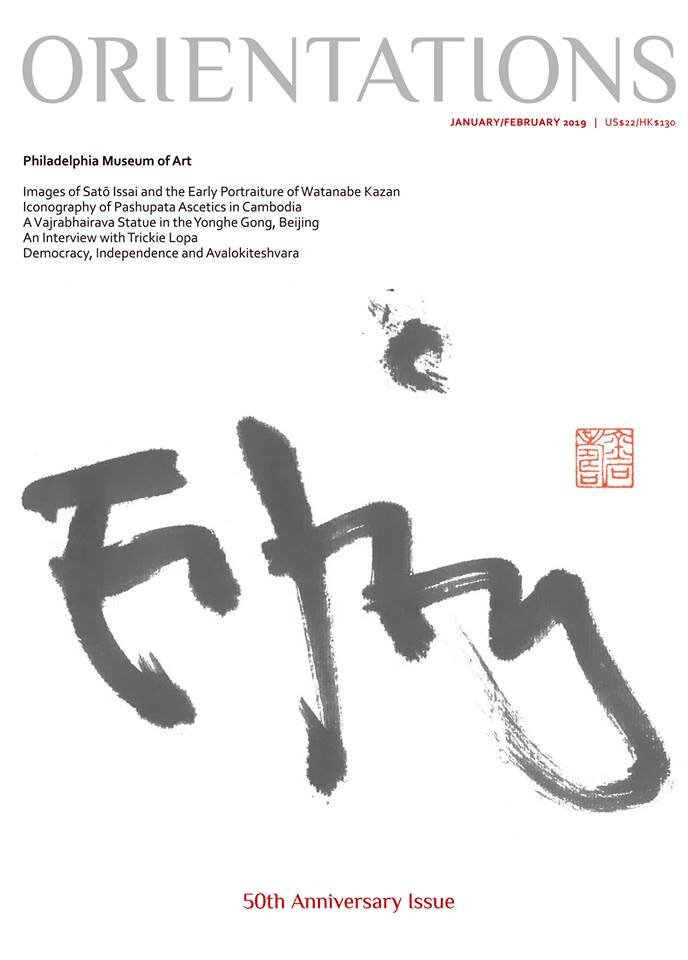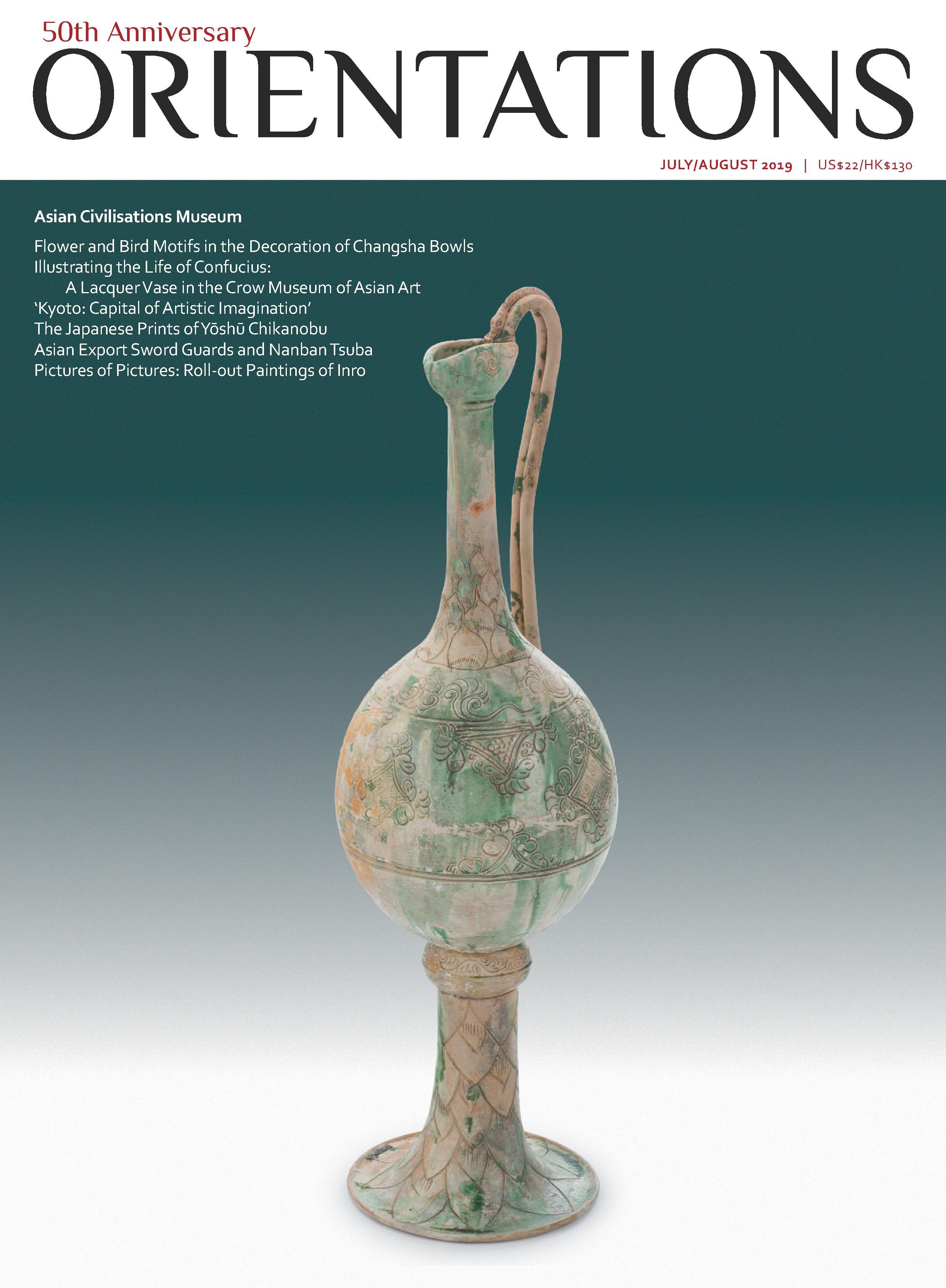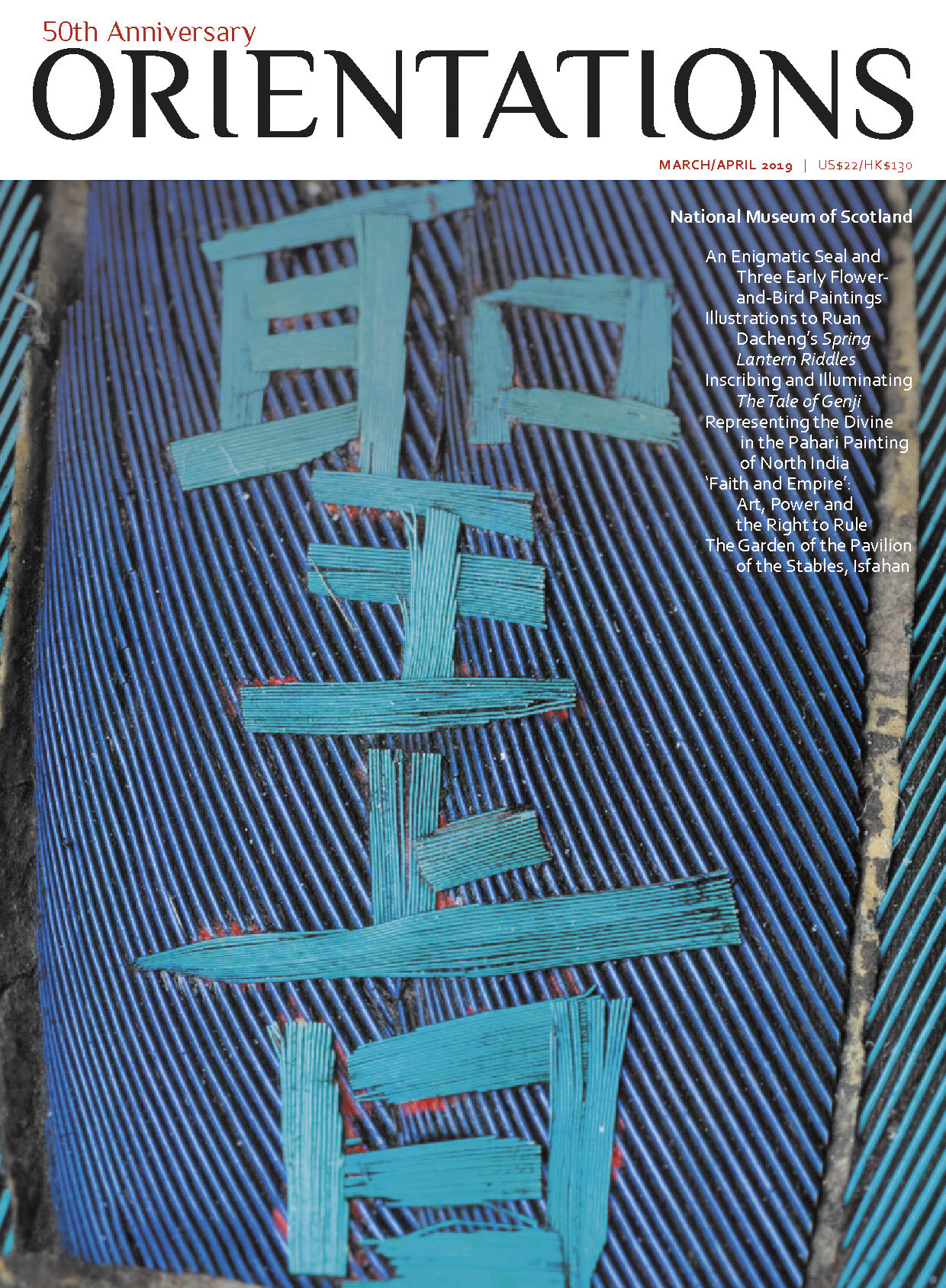MAY/JUNE 2019
VOLUME 50 - NUMBER 3
Material culture is often a source of information that is missing from the historical record. Our first two articles discuss excavated artefacts whose inscriptions and decoration contribute greatly to our knowledge of Chinese history. The first, by Yan Liu, focuses on the lacquerware from the recently discovered Western Han dynasty tomb of the marquis of Haihun. Rare inscriptions offer insights into the regional production of lacquer during the period, while unique imagery sheds light on the tomb occupant’s character. Maria Khayutina’s article spotlights the famous He zun, a libation vessel whose inscription provides evidence for the Zhou dynasty’s beginni
Next, for the second article in our series ‘Asian Art in Design’, Sarah Handler discusses creative pieces incorporating Chinese artworks to produce a different aesthetic, while Gao Feichi examines the illustrations in an unusual polychrome edition of The Origins, Transformations and Deeds of the Buddha (Shishi yuanliu). Richard Pegg continues his exploration of maps and artefacts relating to the maritime trade in Edo period Japan.
Moving on to India, Rob Linrothe once again shares his fieldwork for ‘Art in Context’, this time on Hindu and Buddhist sculpture in the modern state of Odisha. Concentrating on sculptures of Tara and Bhrikuti from this state, Sonali Dhingra illuminates the evolution in the cults of female Buddhist divinities in east India between the late 8th and the 12th centuries. Our line-up of features ends with Clarissa von Spee’s article on a meaningful exhibition of gunpowder art by Cai Guo-Qiang, commemorating a fire on Cleveland’s Cuyahoga river and highlighting humanity’s impact on the environment.
FEATURES
Yan Liu. Lacquerware from the Tomb of the Marquis of Haihun
Maria Khayutina. The Story of the He Zun: From Political Intermediary to National Treasure
Sarah Handler. Chinese Art in Western Creations
Gao Feichi. iIllustrating the Life of the Buddha: A Polychrome Edition of Shishi yuanliu in the Library of Congress
Richard A. Pegg. Early Edo Maritime Trade: Red-seal System Maps and Ships
Sonali Dhingra. Compassion and Wisdom Personified: Some Lesser-known Buddhist Sculptures from Odisha
PREVIEWS & REVIEWS
Rob Linrothe. 'This is it!' Odisha for Art's Sake
Clarissa von Spee. Explosive Stuff- The Cleveland Museum of Art Shows Cai Guo-Qiang
Shelagh Vainker. Auspicious Cranes (Above Kaifeng)
Rose Kerr. Book Review: Silk, Slaves, and Stupas: Material Culture of the Silk Road
NEWS
Jerome Sibergeld. Dora C. Y. Ching. Wen Fong (1930 - 2018)
Liu Yang. A Note Left for Absent Edmund (1940 - 2019)
VOLUME 50 - NUMBER 3
Material culture is often a source of information that is missing from the historical record. Our first two articles discuss excavated artefacts whose inscriptions and decoration contribute greatly to our knowledge of Chinese history. The first, by Yan Liu, focuses on the lacquerware from the recently discovered Western Han dynasty tomb of the marquis of Haihun. Rare inscriptions offer insights into the regional production of lacquer during the period, while unique imagery sheds light on the tomb occupant’s character. Maria Khayutina’s article spotlights the famous He zun, a libation vessel whose inscription provides evidence for the Zhou dynasty’s beginni
Next, for the second article in our series ‘Asian Art in Design’, Sarah Handler discusses creative pieces incorporating Chinese artworks to produce a different aesthetic, while Gao Feichi examines the illustrations in an unusual polychrome edition of The Origins, Transformations and Deeds of the Buddha (Shishi yuanliu). Richard Pegg continues his exploration of maps and artefacts relating to the maritime trade in Edo period Japan.
Moving on to India, Rob Linrothe once again shares his fieldwork for ‘Art in Context’, this time on Hindu and Buddhist sculpture in the modern state of Odisha. Concentrating on sculptures of Tara and Bhrikuti from this state, Sonali Dhingra illuminates the evolution in the cults of female Buddhist divinities in east India between the late 8th and the 12th centuries. Our line-up of features ends with Clarissa von Spee’s article on a meaningful exhibition of gunpowder art by Cai Guo-Qiang, commemorating a fire on Cleveland’s Cuyahoga river and highlighting humanity’s impact on the environment.
FEATURES
Yan Liu. Lacquerware from the Tomb of the Marquis of Haihun
Maria Khayutina. The Story of the He Zun: From Political Intermediary to National Treasure
Sarah Handler. Chinese Art in Western Creations
Gao Feichi. iIllustrating the Life of the Buddha: A Polychrome Edition of Shishi yuanliu in the Library of Congress
Richard A. Pegg. Early Edo Maritime Trade: Red-seal System Maps and Ships
Sonali Dhingra. Compassion and Wisdom Personified: Some Lesser-known Buddhist Sculptures from Odisha
PREVIEWS & REVIEWS
Rob Linrothe. 'This is it!' Odisha for Art's Sake
Clarissa von Spee. Explosive Stuff- The Cleveland Museum of Art Shows Cai Guo-Qiang
Shelagh Vainker. Auspicious Cranes (Above Kaifeng)
Rose Kerr. Book Review: Silk, Slaves, and Stupas: Material Culture of the Silk Road
NEWS
Jerome Sibergeld. Dora C. Y. Ching. Wen Fong (1930 - 2018)
Liu Yang. A Note Left for Absent Edmund (1940 - 2019)
VOLUME 50 - NUMBER 3
Material culture is often a source of information that is missing from the historical record. Our first two articles discuss excavated artefacts whose inscriptions and decoration contribute greatly to our knowledge of Chinese history. The first, by Yan Liu, focuses on the lacquerware from the recently discovered Western Han dynasty tomb of the marquis of Haihun. Rare inscriptions offer insights into the regional production of lacquer during the period, while unique imagery sheds light on the tomb occupant’s character. Maria Khayutina’s article spotlights the famous He zun, a libation vessel whose inscription provides evidence for the Zhou dynasty’s beginni
Next, for the second article in our series ‘Asian Art in Design’, Sarah Handler discusses creative pieces incorporating Chinese artworks to produce a different aesthetic, while Gao Feichi examines the illustrations in an unusual polychrome edition of The Origins, Transformations and Deeds of the Buddha (Shishi yuanliu). Richard Pegg continues his exploration of maps and artefacts relating to the maritime trade in Edo period Japan.
Moving on to India, Rob Linrothe once again shares his fieldwork for ‘Art in Context’, this time on Hindu and Buddhist sculpture in the modern state of Odisha. Concentrating on sculptures of Tara and Bhrikuti from this state, Sonali Dhingra illuminates the evolution in the cults of female Buddhist divinities in east India between the late 8th and the 12th centuries. Our line-up of features ends with Clarissa von Spee’s article on a meaningful exhibition of gunpowder art by Cai Guo-Qiang, commemorating a fire on Cleveland’s Cuyahoga river and highlighting humanity’s impact on the environment.
FEATURES
Yan Liu. Lacquerware from the Tomb of the Marquis of Haihun
Maria Khayutina. The Story of the He Zun: From Political Intermediary to National Treasure
Sarah Handler. Chinese Art in Western Creations
Gao Feichi. iIllustrating the Life of the Buddha: A Polychrome Edition of Shishi yuanliu in the Library of Congress
Richard A. Pegg. Early Edo Maritime Trade: Red-seal System Maps and Ships
Sonali Dhingra. Compassion and Wisdom Personified: Some Lesser-known Buddhist Sculptures from Odisha
PREVIEWS & REVIEWS
Rob Linrothe. 'This is it!' Odisha for Art's Sake
Clarissa von Spee. Explosive Stuff- The Cleveland Museum of Art Shows Cai Guo-Qiang
Shelagh Vainker. Auspicious Cranes (Above Kaifeng)
Rose Kerr. Book Review: Silk, Slaves, and Stupas: Material Culture of the Silk Road
NEWS
Jerome Sibergeld. Dora C. Y. Ching. Wen Fong (1930 - 2018)
Liu Yang. A Note Left for Absent Edmund (1940 - 2019)

